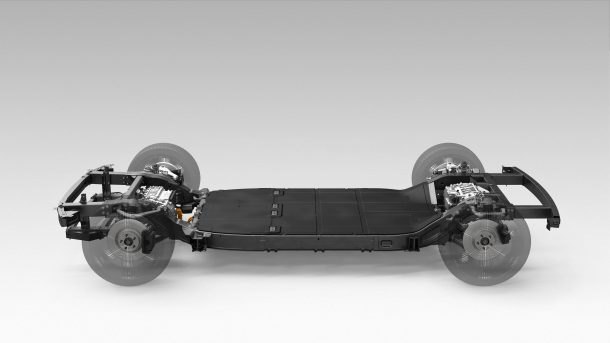Hyundai Taps California Firm for Joint EV Platform

Developing a new vehicle platform in-house is an expensive affair, making the cost of producing an electric vehicle from the ground up a heavy weight to place on an automaker’s balance sheet. Margins for such vehicles are currently slim, if not nonexistent. No wonder everyone’s trying to free up cash.
And yet, because the world has decided EVs are the future, automakers can’t be without them. Ford recently partnered with Michigan startup Rivian to source a platform for an upcoming Lincoln crossover, and now Hyundai has followed suit.
Hyundai and Canoo. Best buddies.
It’s not entirely an off-someone-else’s-shelf proposition. Hyundai has forged an agreement with California-based EV tech startup Canoo to jointly develop a new EV platform from the firm’s existing “skateboard” architecture. Rivian, you’ll recall, has a skateboard of its own, and it’s not shy about letting others use it.
Last September, Canoo slid the platform beneath a box-like EV it intends to sell via a subscription model in 2021.
“As part of the collaboration, Canoo will provide engineering services to help develop a fully scalable, all-electric platform to meet Hyundai and Kia specifications,” Hyundai said in a release.
“Hyundai Motor Group expects the platform to help facilitate its commitment to delivering cost-competitive electrified vehicles — ranging from small-sized EVs to Purpose Built Vehicles (PBV) — that meet diverse customer needs.”
As Hyundai has earned a lasting reputation as a purveyor of value-laden models, a steep markup for a so-badged EV model wouldn’t jibe with the brand’s credo. The current Ioniq Electric is certainly among the cheapest EVs on the market, but one compact hatch — joined by the Kona EV subcompact crossover last year — won’t cut it going into the 2020s. Corporate sibling Kia Motors hosts a similar amount of electrification in its showrooms.
Both brands will have to up the ante to reach Hyundai Motor Group’s goal of drawing 25 percent of its sales from green vehicles by 2025.
The automaker said it “expects an adaptable all-electric platform using Canoo’s scalable skateboard architecture to allow for a simplified and standardized development process for Hyundai and Kia electrified vehicles, which is expected to help reduce cost that can be passed along to consumers.”
Hyundai didn’t mention when the first Canoo-based vehicle might make it to production.
[Image: Canoo]

More by Steph Willems
Latest Car Reviews
Read moreLatest Product Reviews
Read moreRecent Comments
- El scotto Under NAFTA II or the USMCA basically the US and Canada do all the designing, planning, and high tech work and high skilled work. Mexico does all the medium-skilled work.Your favorite vehicle that has an Assembled in Mexico label may actually cross the border several times. High tech stuff is installed in the US, medium tech stuff gets done in Mexico, then the vehicle goes back across the border for more high tech stuff the back to Mexico for some nuts n bolts stuff.All of the vehicle manufacturers pass parts and vehicles between factories and countries. It's thought out, it's planned, it's coordinated and they all do it.Northern Mexico consists of a few big towns controlled by a few families. Those families already have deals with Texan and American companies that can truck their products back and forth over the border. The Chinese are the last to show up at the party. They're getting the worst land, the worst factories, and the worst employees. All the good stuff and people have been taken care of in the above paragraph.Lastly, the Chinese will have to make their parts in Mexico or the US or Canada. If not, they have to pay tariffs. High tariffs. It's all for one and one for all under the USMCA.Now evil El Scotto is thinking of the fusion of Chinese and Mexican cuisine and some darn good beer.
- FreedMike I care SO deeply!
- ClayT Listing is still up.Price has been updated too.1983 VW Rabbit pickup for sale Updated ad For Sale Message Seller [url=https://www.vwvortex.com/members/633147/] [/url] jellowsubmarine 0.00 star(s) (0.0) 0 reviews [h2]$19,000 USD Check price[/h2][list][*] [url=https://www.ebay.com/sch/i.html?_nkw=1983 VW Rabbit pickup for sale Updated ad] eBay [/url][/*][/list] Ceres, California Apr 4, 2024 (Edited Apr 7, 2024)
- KOKing Unless you're an employee (or even if you are) does anyone care where physically any company is headquartered? Until I saw this story pop up, I'd forgotten that GM used to be in the 'Cadillac Building' until whenever it was they moved into RenCen (and that RenCen wasn't even built for GM). It's not like GM moved to Bermuda or something for a tax shelter (and I dunno maybe they ARE incorporated there legally?)
- Fred It just makes me question GM's management. Do they save rent money? What about the cost of the move? Don't forget they have to change addresses on their forms. New phone numbers? Lost hours?

































Comments
Join the conversation
Confused here. ...All this blather about "skateboards" and an accompanying illustration of what is most certainly a frame. Am I to understand that there is a going to be a resurgence of Body on Frame construction for EVs, or are these terms, and illustrations, being used as visual shortcuts for highly versatile, yet difficult to visualize unibody/monocoque style "platforms?"
..